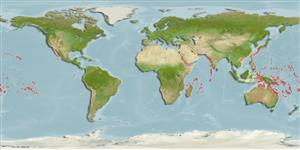Pilidiophora |
Heteronemertea |
Valenciniidae
Environment: milieu / climate zone / depth range / distribution range
Ecology
Benthic. Tropical
Indo-Pacific: Australia to Hawaii and the Red Sea.
Length at first maturity / Size / Weight / Age
Maturity: Lm ? range ? - ? cm
Nemerteans are carnivores feeding mainly on annelids and crustaceans, although a few scavenge for dead animals (Ref. 833).
Life cycle and mating behavior
Maturity | Reproduction | Spawning | Eggs | Fecundity | Larvae
Members of the phylum Nemertea are mostly gonochoric. Life cycle: Eggs hatch and develop into short-lived lecitotrophic larvae before metamorphosing into juveniles and further into adults.
Gibson, R. and P. Sundberg 2001 Some Nemerteans (Nemertea) from Queensland and the Great Barrier Reef, Australia. Zoological Science 18:1259-1273. (Ref. 937)
IUCN Red List Status
(Ref. 130435: Version 2025-1)
CITES status (Ref. 108899)
Not Evaluated
Not Evaluated
Threat to humans
Harmless
Human uses
| FishSource |
Tools
More information
Trophic EcologyFood items (preys)
Diet composition
Food consumption
Predators
Population dynamicsGrowth
Max. ages / sizes
Length-weight rel.
Length-length rel.
Length-frequencies
Mass conversion
Abundance
Life cycleReproductionMaturityFecunditySpawningEggsEgg developmentLarvae PhysiologyOxygen consumption
Human RelatedStamps, coins, misc.
Internet sources
Estimates based on models
Preferred temperature
(Ref.
115969): 25.2 - 29.3, mean 28.1 (based on 1812 cells).
Price category
Unknown.
